Mauricio Breternitz Jr.
Differentiable Weightless Neural Networks
Oct 14, 2024Abstract:We introduce the Differentiable Weightless Neural Network (DWN), a model based on interconnected lookup tables. Training of DWNs is enabled by a novel Extended Finite Difference technique for approximate differentiation of binary values. We propose Learnable Mapping, Learnable Reduction, and Spectral Regularization to further improve the accuracy and efficiency of these models. We evaluate DWNs in three edge computing contexts: (1) an FPGA-based hardware accelerator, where they demonstrate superior latency, throughput, energy efficiency, and model area compared to state-of-the-art solutions, (2) a low-power microcontroller, where they achieve preferable accuracy to XGBoost while subject to stringent memory constraints, and (3) ultra-low-cost chips, where they consistently outperform small models in both accuracy and projected hardware area. DWNs also compare favorably against leading approaches for tabular datasets, with higher average rank. Overall, our work positions DWNs as a pioneering solution for edge-compatible high-throughput neural networks.
ULEEN: A Novel Architecture for Ultra Low-Energy Edge Neural Networks
Apr 20, 2023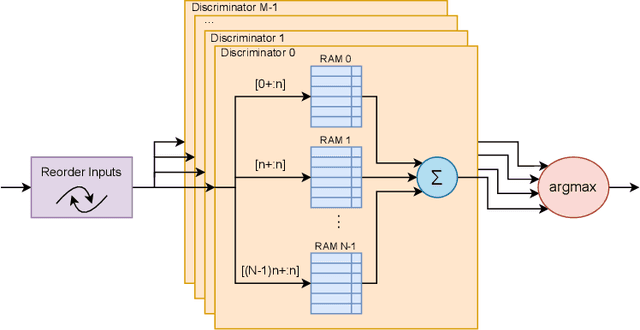
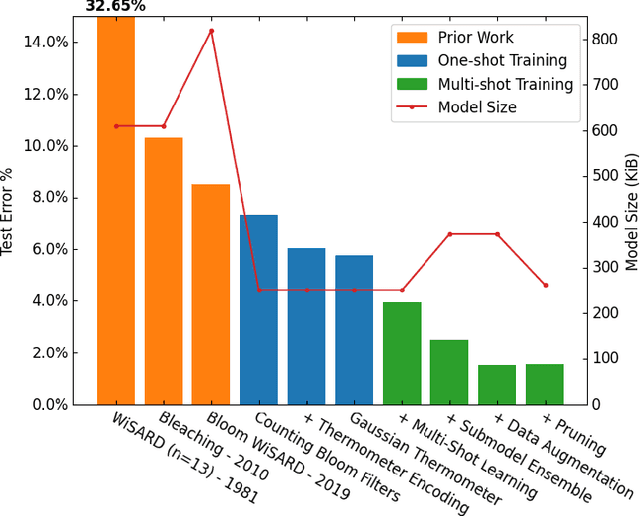
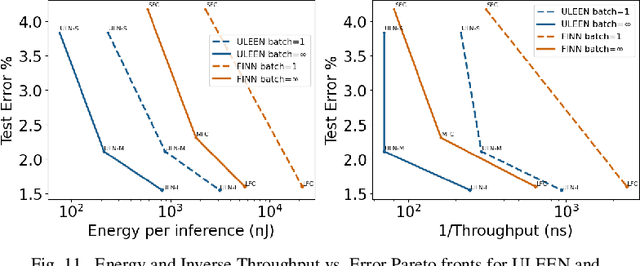
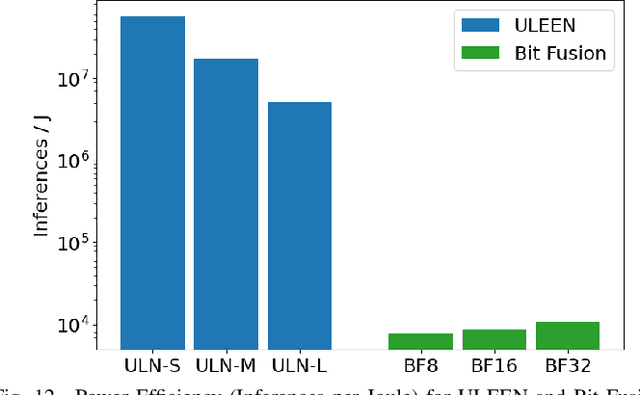
Abstract:The deployment of AI models on low-power, real-time edge devices requires accelerators for which energy, latency, and area are all first-order concerns. There are many approaches to enabling deep neural networks (DNNs) in this domain, including pruning, quantization, compression, and binary neural networks (BNNs), but with the emergence of the "extreme edge", there is now a demand for even more efficient models. In order to meet the constraints of ultra-low-energy devices, we propose ULEEN, a model architecture based on weightless neural networks. Weightless neural networks (WNNs) are a class of neural model which use table lookups, not arithmetic, to perform computation. The elimination of energy-intensive arithmetic operations makes WNNs theoretically well suited for edge inference; however, they have historically suffered from poor accuracy and excessive memory usage. ULEEN incorporates algorithmic improvements and a novel training strategy inspired by BNNs to make significant strides in improving accuracy and reducing model size. We compare FPGA and ASIC implementations of an inference accelerator for ULEEN against edge-optimized DNN and BNN devices. On a Xilinx Zynq Z-7045 FPGA, we demonstrate classification on the MNIST dataset at 14.3 million inferences per second (13 million inferences/Joule) with 0.21 $\mu$s latency and 96.2% accuracy, while Xilinx FINN achieves 12.3 million inferences per second (1.69 million inferences/Joule) with 0.31 $\mu$s latency and 95.83% accuracy. In a 45nm ASIC, we achieve 5.1 million inferences/Joule and 38.5 million inferences/second at 98.46% accuracy, while a quantized Bit Fusion model achieves 9230 inferences/Joule and 19,100 inferences/second at 99.35% accuracy. In our search for ever more efficient edge devices, ULEEN shows that WNNs are deserving of consideration.
Weightless Neural Networks for Efficient Edge Inference
Mar 03, 2022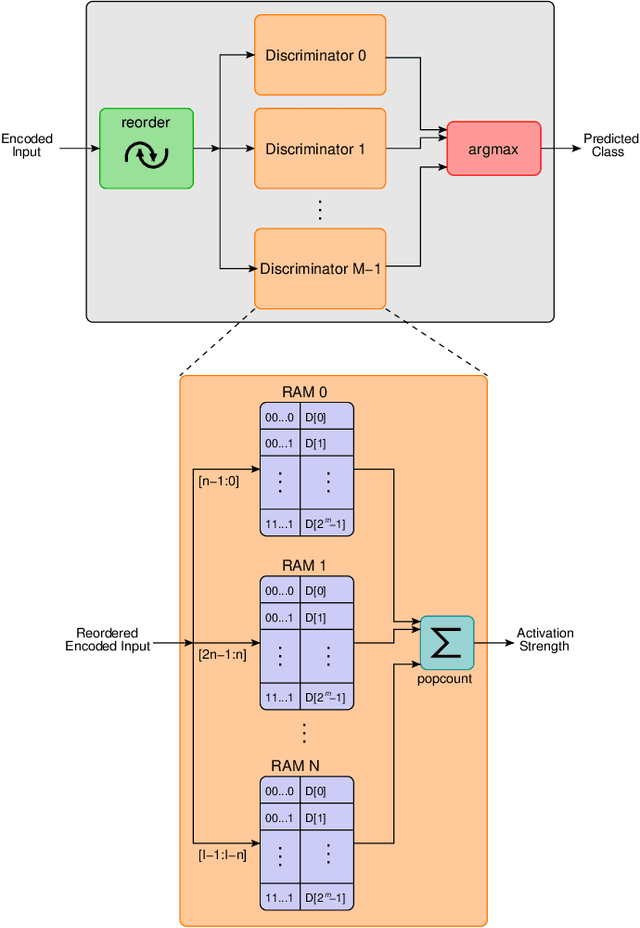
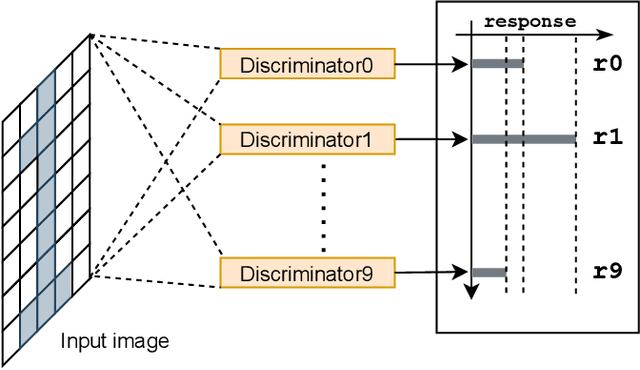

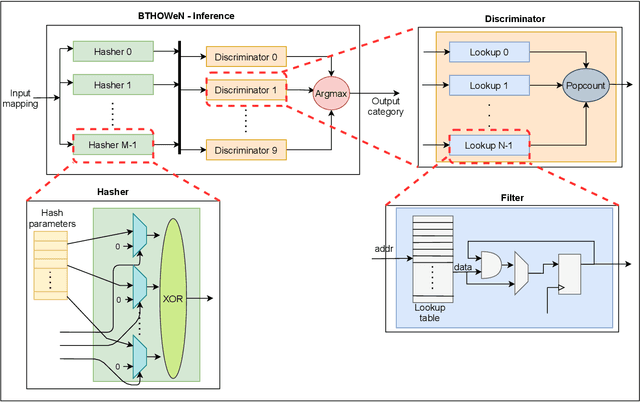
Abstract:Weightless Neural Networks (WNNs) are a class of machine learning model which use table lookups to perform inference. This is in contrast with Deep Neural Networks (DNNs), which use multiply-accumulate operations. State-of-the-art WNN architectures have a fraction of the implementation cost of DNNs, but still lag behind them on accuracy for common image recognition tasks. Additionally, many existing WNN architectures suffer from high memory requirements. In this paper, we propose a novel WNN architecture, BTHOWeN, with key algorithmic and architectural improvements over prior work, namely counting Bloom filters, hardware-friendly hashing, and Gaussian-based nonlinear thermometer encodings to improve model accuracy and reduce area and energy consumption. BTHOWeN targets the large and growing edge computing sector by providing superior latency and energy efficiency to comparable quantized DNNs. Compared to state-of-the-art WNNs across nine classification datasets, BTHOWeN on average reduces error by more than than 40% and model size by more than 50%. We then demonstrate the viability of the BTHOWeN architecture by presenting an FPGA-based accelerator, and compare its latency and resource usage against similarly accurate quantized DNN accelerators, including Multi-Layer Perceptron (MLP) and convolutional models. The proposed BTHOWeN models consume almost 80% less energy than the MLP models, with nearly 85% reduction in latency. In our quest for efficient ML on the edge, WNNs are clearly deserving of additional attention.
Efficiency and Scalability of Multi-Lane Capsule Networks (MLCN)
Aug 11, 2019



Abstract:Some Deep Neural Networks (DNN) have what we call lanes, or they can be reorganized as such. Lanes are paths in the network which are data-independent and typically learn different features or add resilience to the network. Given their data-independence, lanes are amenable for parallel processing. The Multi-lane CapsNet (MLCN) is a proposed reorganization of the Capsule Network which is shown to achieve better accuracy while bringing highly-parallel lanes. However, the efficiency and scalability of MLCN had not been systematically examined. In this work, we study the MLCN network with multiple GPUs finding that it is 2x more efficient than the original CapsNet when using model-parallelism. Further, we present the load balancing problem of distributing heterogeneous lanes in homogeneous or heterogeneous accelerators and show that a simple greedy heuristic can be almost 50% faster than a naive random approach.
 Add to Chrome
Add to Chrome Add to Firefox
Add to Firefox Add to Edge
Add to Edge